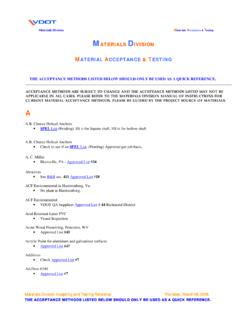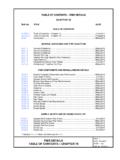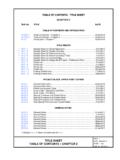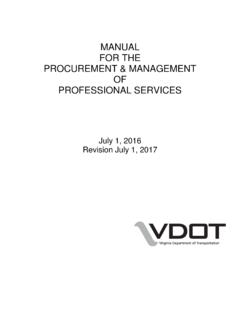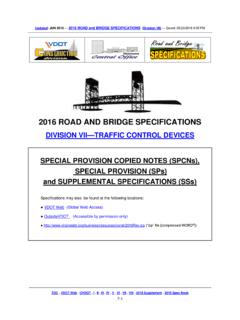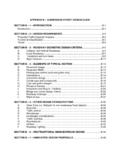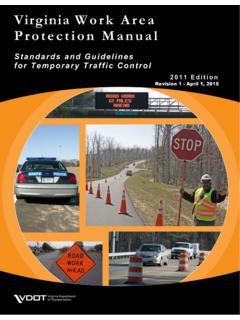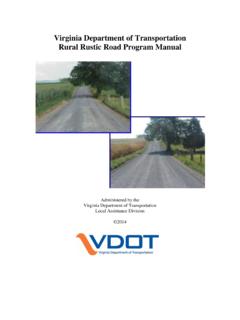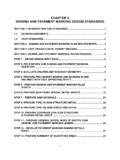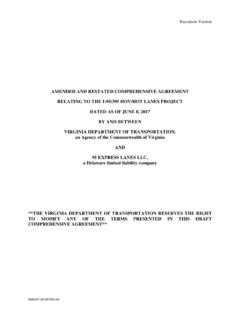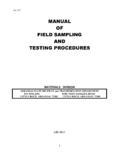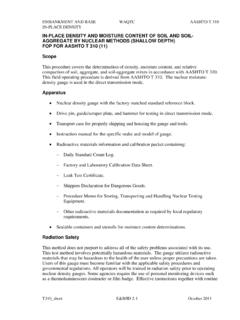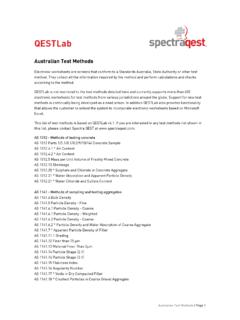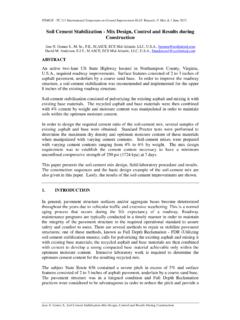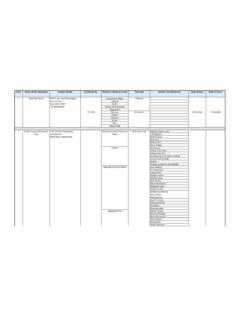Transcription of FIELD MOISTURE AND DENSITY TESTING WITH THE …
1 VDOT Soils and aggregate Compaction Chapter 6 | 1 6 FIELD MOISTURE AND DENSITY TESTING with THE NUCLEAR GAUGE LEARNING OUTCOMES Understand the components of the nuclear gauge and how it is used to measure MOISTURE and DENSITY Understand the procedures for evaluating MOISTURE and DENSITY using the direct transmission method Understand the basic regulations that govern the storage, transport, and use of the nuclear gauge Understand basic maintenance techniques and procedures for emergency response INTRODUCTION After placement and compaction of the embankment material by the contractor, the inspector then conducts a FIELD DENSITY test and a FIELD MOISTURE content test on the lift.
2 The results of these FIELD tests are compared to the target values (see Chapter 5) to determine if the contractor has met specifications for DENSITY and MOISTURE content of that lift. Section (h) and (a) of 2007 Road and Bridge Specifications stipulates that FIELD DENSITY determinations are to be performed in accordance with the following AASHTO tests: T191 DENSITY of Soil in Place by the Sand Cone Method T310 DENSITY of Soil in Place by the Nuclear Gauge SOIL DENSITY TESTING FLOW CHART Setting Target Values Laboratory Proctor One Point Proctor Running FIELD Tests Speedy MOISTURE Test Drying MOISTURE Test Sand Cone DENSITY Test Nuclear Gauge DENSITY Test Is Specification Met? MOISTURE (Yes/No) DENSITY (Yes/No) VDOT Soils and aggregate Compaction Chapter 6 | 2 TROXLER 3440 NUCLEAR GAUGE (FOR SOILS AND aggregate MATERIAL) VDOT Soils and aggregate Compaction Chapter 6 | 3 DETERMINING FIELD DENSITY & MOISTURE CONTENT with THE NUCLEAR GAUGE The Nuclear MOISTURE DENSITY device (or Nuclear Gauge)
3 Is specifically designed to measure the MOISTURE and DENSITY of soils, aggregates, cement, and lime treated materials, and to measure the DENSITY of asphalt concrete. It offers the Inspector and Contractor a method of obtaining fast, accurate and in place measurement of densities and MOISTURE . with suitable calibrations, the device gives results which are comparable to those given by the Sand Cone or Volume Meter Test. The device uses a small radioactive source which sends radiation through the material being tested, giving data which can be correlated to DENSITY and/or MOISTURE . While no radiation hazard is imposed on the operator when following the normal procedures of use, a potential hazard does exist if improperly used. Three ways to limit exposure to radiation are time, distance, and shielding.
4 Before operating a nuclear gauge a person must pass a Nuclear Safety course and be issued a thermoluminescent dosimeter (TLD) badge. The badge measures exposure to radiation and is to be worn whenever operating a nuclear gauge. The TLD is to be stored at least 10 feet from the gauge. Two gauges should not be operated within 33 feet of one another. In case of an accident, maintain a 20 foot radius around the accident site. COMPONENTS OF THE NUCLEAR GAUGE A small radioactive source is located in the tip of the stainless steel rod which is primarily used for DENSITY TESTING , whereas another source is located inside the device which is used specifically for taking MOISTURE determinations simultaneously. The probe rod is capable of being moved to the various desired depths, as shown on the following pages.
5 The positions are stamped on the guide rod for easy determination of the proper depths. The 3440 Nuclear Gauge provides three different count times to be used for taking readings. The 15 second setting is recommended to be used only in the roller pattern test method (Backscatter Method). The one minute setting is used for all embankment and subgrade materials. The four minute setting is generally used for calibration. VDOT Soils and aggregate Compaction Chapter 6 | 4 TROXLER 3440 NUCLEAR GAUGE (HANDLE POSITIONS) TROXLER 3440 NUCLEAR GAUGE (BASE AND DISPLAY SCREEN)
6 VDOT Soils and aggregate Compaction Chapter 6 | 5 NUCLEAR GAUGE THEORY OF OPERATIONS The Nuclear Gauge is specifically designed to measure the MOISTURE content and DENSITY of soils, aggregates, cement and lime treated materials, and to measure the DENSITY of Bituminous Concrete. It offers the inspector a method of obtaining fast, accurate, in place measurement of DENSITY and MOISTURE . with suitable laboratory calibrations, and proper FIELD operation of the gauge, the device gives results which are comparable to those given by the sand cone or volume meter tests. The tip of the source rod contains a small radioactive source (Cesium 137) which emits gamma rays.
7 Detectors in the base of the gauge measure this radiation and calculate the DENSITY of the material. The gauge has two modes to measure DENSITY : the direct transmission mode and backscatter mode. In the Direct Transmission mode, the source rod is inserted into the material to be tested to the desired depth of test. The 6 inch depth is the most recommended depth for TESTING densities and MOISTURE content simultaneously in soils used in backfills, embankments and subgrade. The 4 inch depth is used for backfilling around pipe and abutments where hand tamping and pneumatic tamping is used. The 8 inch depth is only used when specified on the contract. In the backscatter mode, the gauge is placed on the material to be tested and the source rod is locked in the first position below the SAFE position.
8 Since the rod is flush with the bottom of the gauge and no hole is required for the rod, the backscatter mode is used only in conjunction with the roller pattern/control strip method for TESTING densities on asphalt concrete and all aggregate material such as base, subbase, and select materials. VDOT Soils and aggregate Compaction Chapter 6 | 6 The gauge has an internal radioactive source (Americium 241: Beryllium) that emits neutrons which measure the hydrogen to determine MOISTURE content. Any position below the SAFE position can be used to determine MOISTURE content.
9 Problems may arise when TESTING materials containing mica, boron, cadmium and chlorine or when TESTING heavy clays and organic material. It is permissible to use the Speedy MOISTURE Tester to verify nuclear results. Like the conventional test, the operator must compare the results from the nuclear gauge to the one point proctor or laboratory proctor. The nuclear DENSITY is compared to the maximum dry DENSITY to calculate the percent DENSITY and the MOISTURE content from the nuclear gauge is compared to the optimum MOISTURE limits. PRETEST WARM UP PROCEDURES FOR THE 3440 NUCLEAR GAUGE The standard count should be taken daily before any TESTING is done to check gauge operation and allow the gauge to compensate for natural source decay.
10 The 3440 gauge should be turned on and allowed to go through the self test (RAM TEST) before beginning. (NOTE: It is very important that the RAM TEST display has ended before proceeding. During the test, the screen will display a count down from 300 seconds and then display READY on the screen.) Place the reference block on a flat surface with a minimum DENSITY of 100 lbs/ft3 at least 10 feet from any structure and 33 feet from any other radioactive source, in the same manner as when using any other model gauge. Place the gauge on the reference block, making sure that it is seated flat and within the raised edges, with the right side of the gauge pushed firmly against the metal plate on the block. Press STANDARD on the finger keypad for the display: Press YES to enter the new counts into memory.
